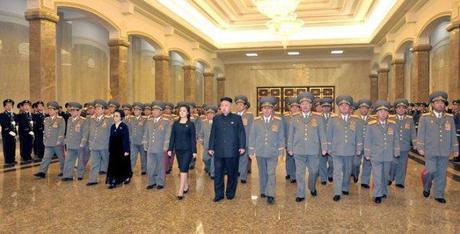
Kim Jong Un (C) pays his respects to statues of his father Kim Jong Il and his grandfather Kim Il Sung at Kumsusan in Pyongyang on 16 February 2013. (Photo: Rodong Sinmun)
DPRK state media reported on 16 February (Saturday) that Kim Jong Un (Kim Cho’ng-u’n) visited the Ku’msusan Memorial Palace of the Sun and attended a statue unveiling ceremony at Mangyo’ngdae Revolutionary School to commemorate Kim Jong Il’s birthday. KJU’s last reported public appearance was his attendance and participation at a watch presentation ceremony. KJU’s first visit was to pay his respects to the remains of his father, late leader Kim Jong Il, at Ku’msusan. He was accompanied by his wife Ri Sol Ju. Also in attendance were VMar Choe Ryong Hae, Jang Song Taek, Gen. Hyon Yong Chol, Kim Kyong Hui, Pak To Chun, VMar Kim Yong Chun, VMar Hyon Chol Hae and members of the Korean Workers’ Party [KWP] Central Military Commission [CMC], the DPRK National Defense Commission, members of the Korean People’s Army Supreme Command staff and senior KPA commanders Ju Kyu Chang, Gen. Kim Kyong Ok, Gen. Yun Jong Rin, Col. Gen. Choe Pu Il, Col. Gen. Ri Yong Gil, Col. Gen. Son Chol Ju, Lt. Gen. Ryom Chol Song, Col. Gen. Jo Kyong Chol, Gen. Yun Tong Hyon, Gen. Kang Phyo Yong, Gen. Ri Pyong Chol, Lt. Gen. Kim Rak Gyom, Lt. Gen. Pak Jong Chon, Col. Gen. Kim Chun Sam, Col. Gen. Kim Yong Chol and Col. Gen. Jon Chang Bok, among others.
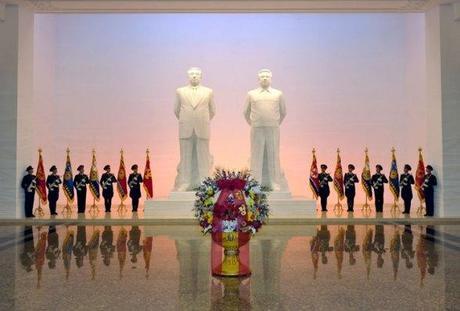
A floral basket from Kim Jong Un in front of statues of his grandfather Kim Il Sung and father Kim Jong Il at Ku’msusan in Pyongyang on 16 February 2013 (Photo: Rodong Sinmun)
Kim Jong Un and assembled company visited the statue hall for a ceremony at which an honor guard saluted the statues of Kim Il Sung and Kim Jong Il and a sereis of floral baskets were placed before the statues. KJU “entered the hall of immortality where Kim Jong Il lies in state” and “together with the participants, made bows to Kim Jong Il in the humblest reverence.” After paying their respects, Kim Jong Un and members of the central leadership visited the exhibition of KJI’s personal affects and personal vehicles.
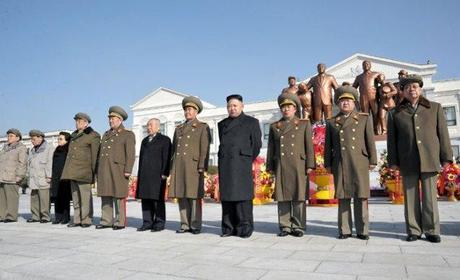
Kim Jong Un (4th R) and members of the central leadership stand in front of statues of Kim Il Sung and Kim Jong Il during an unveiling ceremony on the campus of Mangyo’ngdae School on 16 February 2013. Among those in attendance in this image are: Gen. O Kuk Ryol (L), VMar Ri Yong Mu (2nd L) Kim Kyong Hui (3rd L), Kim Ki Nam (4th L), Choe Yong Rim (6th L), Mangyo’ngdae School principal O Ryong Thaek (7th L), VMar Choe Ryong Hae (2nd R) and Jang Song Taek (R) (Photo: Rodong Sinmun)
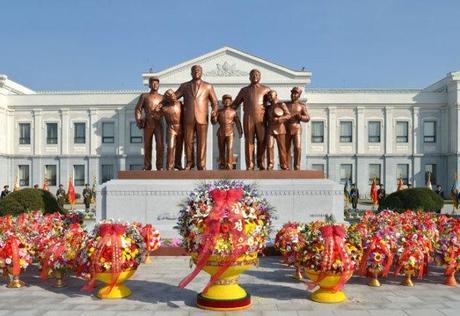
A statue of late DPRK founder and president Kim Il Sung and late leader Kim Jong Il unveiled on the campus of the Mangyo’ngdae Revolutionary School in Pyongyang on 16 February 2013 (Photo: Rodong Sinmun)
Kim Jong Un later visited Mangyo’ngdae Revolutionary School on Saturday where new statues of Kim Jong Il and Kim Il Sung were unveiled and dedicated. The statues depict KJI and KIS and embracing Mangyo’ngdae School students. Attending the ceremony with KJU were DPRK Cabinet Premier Choe Yong Rim, Director of the KPA General Political Department VMar Choe Ryong Hae, NDC Vice Chairman and KWP Administration Department Director Jang Song Taek, Chief of the KPA General Staff Gen. Hyon Yong Chol, Minister of the People’s Armed Forces Gen. Kim Kyok Sik, KWP Secretary and Department Director Kim Kyong Hui, KWP Secretary and Department Director Kim Ki Nam, NDC Vice Chairman and KWP Civil Defense Department Director VMar Kim Yong Chun, NDC Vice Chairman VMar Ri Yong Mu, NDC Vice Chairman Gen. O Kuk Ryol, 1st Vice Minister of the People’s Armed Forces and Director of the KPA General Logistics Department VMar Hyon Chol Hae and immediate past Minister of the People’s Armed Forces, Gen. Kim Jong Gak along with “officials of the party and armed forces organs, staff members and students of the school and its graduates, officials of units and military academies at all levels, service personnel of the KPA, military family members and officials and employees of the units who contributed to the erection of the statues and Pyongyangites.”

Ceremony unveiling a new statue of Kim Il Sung and Kim Jong Il on Mangyo’ngdae Revolutionary School’s campus in Pyongyang on 16 February 2013 (Photos: Rodong Sinmun)

The new statue (L) replaces an older statue of Kim Il Sung that had been on Mangyo’ndae Revolutionary School campus for a number of years. The old KIS statue can seen in these images from Kim Jong Un’s visit to the school in early 2012 (C) and in the background in a photo from a DPRK publication from the 1960s (R) (Photos: Rodong Sinmun, KCTV screengrab and Foreign Languages Publishing House)
Choe Yong Rim, VMar Choe Ryong Hae and Jang Song Taek formally unveiled the KJI and KIS statues. After the ceremonious unveiling of the statues floral baskets from Kim Jong Un, the KWP Central Committee and Central Military Commission and DPRK National Defense Commission (sent jointly), the KPA General Political Department, the KPA General Staff, the Ministry of the People’s Armed Forces, various KPA units and KPA military schools and training center were placed before the statues. According to KCNA, ceremony participants “paid tribute to the Generalissimos in humblest reverence.” Choe Ryong Hae delivered the ceremony’s keynote address. According to a gist in KCNA Choe said:
Kim Jong Il deemed it as an important work for giving steady continuity to the bloodline of revolution to educate the children of revolutionary martyrs from the first day of his revolutionary leadership and paid deep attention to the work of the school in the grim days of leading to victory the confrontation with the U.S. and the struggle for defending socialism under the uplifted banner of Songun.
It was the unanimous desire of all teachers and pupils of the school and service personnel of the KPA to erect the statue of Kim Jong Il at the school where people erected Kim Il Sung’s statue for the first time in Korea at the initiative of anti-Japanese war hero Kim Jong Suk who took into consideration the ardent desire of the schoolers to see Kim Il Sung every day.
The ardent desire of the teachers and pupils and all service personnel has become a brilliant reality thanks to the intense loyalty and meticulous guidance of Marshal Kim Jong Un.
Rosy is the future of the children of revolutionary martyrs, the speaker said, calling for waging a dynamic struggle to reunify the country and accomplish the Juche-based revolutionary cause of Songun under the leadership ofKim Jong Un, the banner of eternal victory of the great Paektusan nation, as befitting the descendants of Generalissimo Kim Il Sung and the soldiers and disciples of Generalissimo Kim Jong Il.
After the speaking program, according to KCNA, Kim Jong Un “warmly acknowledged the cheers of all the participants.”

Kim Jong Il (L) and his mother Kim Jong Suk on a visit to Mangyo’ngdae Revolutionary School (R) in (ca.) 1947 (Photo: Foreign Languages Publishing House/Party History Institute)
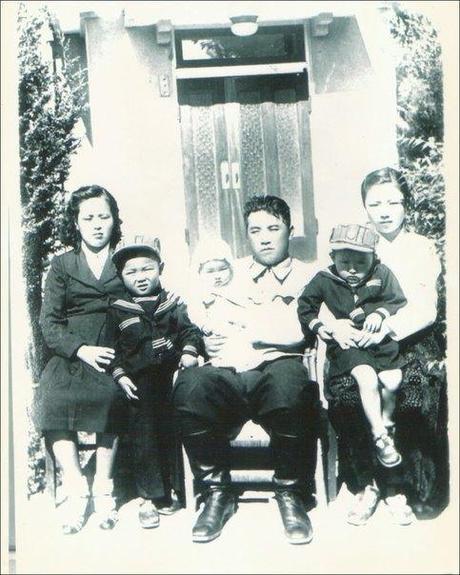
Image of the Kim Family in 1946. In this image are Kim Jong Suk (L, seated), Kim Jong Il (2nd L) Kim Kyong Hui (3rd L), Kim Il Sung (4th L, seated) Kim Pyong Il (4th L) and of the children’s caretakers, possibly Hong Ki-yo’n (5th L)
Leadership Notes
According to the official chronicles Kim Jong Il was born in a small wood house near Mt. Paektu on 16 February 1942. According to Russian records, Kim Jong Il was born in February 1941 on a military base in Khabarovsk which housed members of the 88th Sniper Brigade under the Soviet Far East Command, of which KJI’s parents Kim Il Sung (1912-1994) and Kim Jong Suk (1917-1949) were members. KJI grew up among Koreans, Korean-Chinese and Russians stationed on the base and was called by his Russian name Shura (or Yuri) In his early childhood, KJI saw very little of Kim Il Sung, who traveled to Moscow twice or who was otherwise recovering from injuries and illnesses. In 1944 Kim Jong Suk gave birth to a second son, Kim Pyong Il (whose Russian name was Alexandre), who died in 1947 after he drowned in a water retention pond at the family’s residence in Pyongyang. In 1946, in Pyongyang, Kim Jong Suk gave birth to her last surviving child, daughter Kim Kyong Hui, currently a KWP Secretary and Department Director and one of the most powerful members of the DPRK elite. Kim Jong Suk passed away in September 1949 due to complications from an extra-uterine pregnancy.
In an interesting move to commemorate the official 71st anniversary of Kim Jong Il’s birth, a new statue of KJI and his father was unveiled on the campus of the Mangyo’ngdae Revolutionary School. There are a number of statues of Kim Il Sung (and as of 2012, KJI) around the DPRK, since the inception of the cult around Kim Il Sung and the Mangyo’ngdae Family (KIS, KJI, KJS and KJU). However, the construction of the first known KIS statue and its dedication were initiated by Kim Jong Suk with the first KIS statue placed on the campus of the Mangyo’ngdae Revolutionary School in 1947.
Pyongyang watchers might also note the manner of dress of members of the core leadership at the visit to Ku’msusan and the statue dedication. On the visit to Ku’msusan, senior male officials were attired in variants of the KPA dress uniform. At the statue unveiling ceremony, some senior officials were attired in the clothing of senior party officials. Also note that at Ku’msusan, Jang Song Taek stands at Kim Jong Un’s left in the image (Ri Sol Ju stands at KJU’s right), the same position at which he stood when KJU visited the memorial palace on 24 December 2012.

Jang Song Taek (in a KPA dress uniform) at KJU’s visit to Ku’msusan on 16 Feburary 2013 (L) and on 24 December 2012 (R) (Photos: Rodong Sinmun)
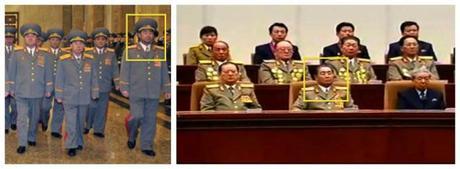
Kim Jong Gak visits Ku’msusan on 16 February 2013 (L) and attends a national report meeting commemorating KJI’s birth anniversary on 15 February 2013 (Photos: Rodong Sinmun and KCTV screengrab)
One of the most notable senior officials attending both events was Gen. Kim Jong Gak. Gen. Kim (who was seemingly reduced in rank from Vice Marshal) joined KJU on his visit to Ku’msusuan and stood in the front row with KJU and other senior officials. Kim Jong Gak also attended the national report meeting commemorating KJI’s at Pyongyang Indoor Stadium on 15 February (Friday), where he was seated on platform (rostrum) in the front row. In November Kim Jong Gak was removed from his previous position as Minister of the People’s Armed Forces, and replaced by Gen. Kim Kyonk Sik.
Filed under: 2013 Day of the Shining Star (KJI Birthday), Administration Department, Central Committee, Central Military Committee, central party life, Choe Ryong Hae, Choe Yong Rim, Civil Defense Department, Col. Gen. Jon Chang Bok, Col. Gen. Son Chol Ju, colonel general, corps command, corps commanders, Culture Section (bureau), DPRK Cabinet, DPRK Premier, Events Management Section, Gen. Choe Pu Il, Gen. Kang Phyo Yong (MPAF), Gen. Kim Kyok Sik, Gen. Kim Won Hong, Gen. Kim Yong Chol, Gen. Ri Pyong Chol, Gen. Yun Jong Rin, gsd, gsob, Guard Command, Hyon Yong Chol, Jang Song-thaek, Kim Chong-un inspections, Kim Family, kim jong suk, Kim Jong Un Visits, Kim Jong-il, Kim Jong-un, Kim Ki Nam, Kim Kyong Ok (OGD), Kim Sol Song (Kim Sul Song), KJI death, KJI Personal Secretariat, KKH, Korean People's Army (KPA), Korean Workers' Party (KWP), KPA General Political Bureau, KPA General Political Department, KPA General Staff, KPA Large Combined Units, KPA Strategic Rocket Force Command, KPA supernumerary organizations, kpaf, Light Industry Department, Lt. Gen. Kim Rak Gyom (SRFC), Lt. Gen. Pak Jong Chon, Lt. Gen. Ri Yong Gil, Machine Building Industry Department, Mangyo'ngdae Revolutionary School Alumni, military security command [msc], ministry of people's security, Ministry of State Security, Ministry of the People's Armed Forces (MPAF), MPAF GPB, National Defense Commission (NDC), national holidays, Navy Command, NDC Administration Department, North Korean press, O Kuk Ryol, O Kuk-yol, Organization and Guidance Department, Pak To Chun, Party elders, Party History Institute, Political Bureau, Propaganda and Agitation Department, Pyongyang Defense Command, Reconnaissance Bureau, reserve training units, Ri Sol Ju (Kim Jong Un's wife), Secretariat, State Security Department, Supreme People's Assembly, VMar Hyon Chol Hae, VMar Kim Jong Gak, VMar Kim Yong Chun, VMar Ri Yong Mu, worker peasant red guard, Working Organizations, XI Army Corps (SOF), Young Red Guard
